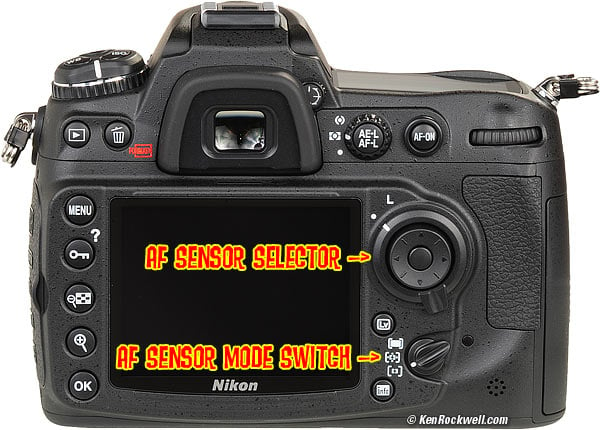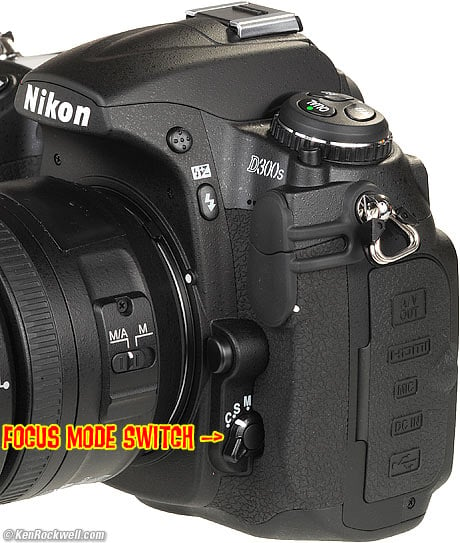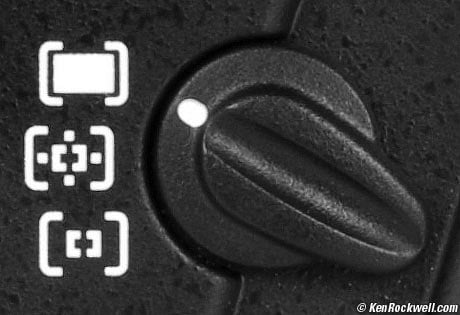Home Donate New Search Gallery How-To Books Links Workshops About Contact
Nikon D300s AF Settings
© 2009 KenRockwell.com. All rights reserved.
Nikon D300s Rear AF Controls.
October 2009 Nikon D300s Review More Nikon Reviews
NEW: Nikon D300s User's Guide iPhone and iPod App.
|
I personally buy from Adorama, Amazon, Ritz, B&H, Calumet and J&R. I can't vouch for ads below.
|
This is specific to the Nikon D300s. See also my Guide to Nikon AF Settings for other cameras.
Nikon D300s Focus Mode Switch.
External Controls
There are three controls, one on front and two on the back.
Focus Mode Switch (front)
The front Focus Mode Switch selects manual, or two kinds of autofocus.
M is manual focus, like the 1950s.
S is "AF-Single," in which position the camera focuses and then locks.
C is "AF-Continuous," meaning the camera constantly tracks focus as the subject moves in and out.
AF Sensor Selector (rear top)
On the back, the top AF Sensor Selector (shown at top of page) selects among the many AF sensors, if you want to.
AF Sensor Mode Switch (rear bottom)
The lower rear switch is the AF Sensor Mode Switch. It chooses how the camera uses all, few or one, of the many AF sensors.
Nikon D300s rear AF Sensor Mode Switch.
There are three positions. From top to bottom, I call them the Big White Rectangle, the Crosshair, and the Tit.
Each shows what AF sensors will be used.
The Big White Rectangle mode lets the camera chose the AF points itself by magic. That's why it's a big rectangle: the D300s uses whichever sensors it wants. It works great, but it can take the D300s a moment to pause to figure it out for each shot.
The middle Crosshair position lets you choose the sensor, and then the camera moves it around to track action as selected by you in CSM a3 (MENU > CUSTOM SETTING MENU > a Autofocus > a3). The graphic shows a single sensor, with lines showing that it can move as chosen next by the camera. The D300s can move it in any direction, not just the fours ways shown in the icon.
The bottom "Tit" position selects only one fixed sensor at a time. The icon shows just one fixed sensor.
Nikon's Default
As shipped, move the front Focus Mode Selector to S, for AF-Single, point the camera at the subject, hold the shutter halfway, recompose, and shoot.
This is exactly the same way Nikon's N2020 worked — back in 1985.
The N2020 was marketed as "Dual Autofocus." That means it also had a continuous motion tracking mode. That's the C, as is Continuous, position of all Nikons today.
Move the switch to "C" to track moving subjects, however you're still stuck with the center sensor.
To get 23 years of improvements, you have to change the other settings.
AF-S always focuses and locks, and AF-C always keeps tracking the subject.
The AF Sensor Selector on the back has been the same since the F5 of 1996. Nikon calls this the "Multi Selector." Tapping the center gets you back to the center sensor. If you knock the "L - •" lever to "L," you'll lock yourself out of selecting the AF points, even though you can still navigate the menus.
My Favorite Settings
The D300s has so many AF sensors and has such intelligent logic that I often set my D300s to the "dummy" Big White Rectangle mode. In this mode, the D300s magically and automatically identifies the correct AF sensor (or sensors) and uses them.
I no longer have to pretend it's the 1990s and choose sensors manually, or pretend that it's the 1980s (or 1950s) and re-compose after focusing.
Even though the D300s has the same AF sensor and settings as the D3, the D300s lacks the D3's computing horsepower to interpret all this data as fast. The D300s doesn't always figure out which sensor to use fast enough, so if it's too slow for you in the Big White Rectangle mode, you may need to use the old-fashioned modes of picking AF sensors yourself.
Here's how I set my cameras. If I don't mention a setting, I leave it at default or it's not related to focus.
Front Focus Mode Switch: C, for AF-C, continuous tracking AF.
Custom Setting Menu a1 (AF-C Priority selection): I set "Release + Focus."
In the default of "Release priority," the camera just shoots, whether of not you're in focus. I never get any other than the first shot or two of a series in focus at this setting. It's a silly setting which makes the camera work fast in the store, but sucks for moving subjects.
In "Focus priority," the camera waits until each and every shot is in perfect focus. This slows it down — a lot. This is the default for the AF-Single setting for still subjects, but a bad idea for moving subjects.
"Release + Focus" is an in-between setting. In this position, most of my sequence shots are in focus. I hit the shutter, and my D300s shoots as soon as it figures out which sensors to use in the Big White Rectangle mode, or immediately in the other sensor modes (Crosshair or Tit).
Set this way, the D300s usually just shoots. If you're way out-of-focus you'll get a fuzzy first shot, but you won't miss it and the D300s will be in focus for the next shot as fast as it can.
Rear AF Sensor Mode Switch: I usually set it to the top setting, the Big White Rectangle. This means D300s magically picks the right sensors itself.
The D300s doesn't always choose the right sensor, and it isn't always that fast (like the D3), so for many uses, I'll use the Crosshair or Tit setting to pick a sensor myself.
When I chose the sensor, it speeds up the D300s since the D300s doesn't need to sort sensors itself. This is one of the biggest differences between the D3 and D300s: the D3 automatically chooses sensors, and chooses the right ones, instantly in Big White Rectangle mode.
I can flick the AF Sensor Mode Switch without taking my eye from the finder, and I do whenever I need to.
By setting the Custom Setting Menu a3 (Dynamic AF Area) to 51 Points (3D Tracking) in AF-C and the Crosshair mode, your manually-chosen AF point will magically move all around the frame tracking your subject! You'll see it move all around, and it really works. This only works in the Crosshair and AF-C mode; it doesn't move around in the Big White Rectangle, Tit or AF-S modes.
This tracking mode gives us another way to shoot if you don't want to select a single AF sensor near your subject. If you prefer, you can autofocus with the center sensor, and in this 51-point 3D tracking mode, keep your finger on the shutter and the AF area will move all by itself, tracking the subject as you recompose!
More Settings
The settings above let me just shoot. They work for sports and for still subjects. I just grab the camera and shoot. In AF-C and White Rectangle Modes, no AF sensors light up. You just shoot.
Stills
If I'm shooting still subjects, I'll chose the AF-S (single) mode on front. Now, in Big White Rectangle Mode, the selected sensors light up, and the focus locks as long as I hold the shutter halfway. If the camera's not magically selecting the sensors I want, I'll select them myself in the lowest "dot" (single-sensor) mode of the Rear AF Mode Selector.
I usually shoot the D300s in the Crosshair or single-sensor mode since the D300s isn't as fast to select sensors automatically.
You're in luck if many sensors light in AF-S and Big White Rectangle modes. This means the camera knows all these areas are in perfect focus.
Sports
For sports with a lot of people running around, use AF-C, the 3D menu option (CSM a3), and the Crosshair mode on the AF Sensor Mode Switch. Now tell the camera which player is yours, and it will track them all over the frame.
Movies
The D300s' AF system is awful for movies. It doesn't work.
Hold the AF-ON button for focus. Good luck.
Summary
I set the front Focus Mode Switch of my D300s to AF-S for still subjects, and AF-C for moving subjects.
My D300s isn't always fast enough to figure things out with the rear AF Sensor Mode Switch in the Big White Rectangle position. Therefore I usually run my D300s in the middle (Crosshair) position of the AF Sensor Mode Switch.
If I am in the Big White Rectangle mode and the D300s needs help finding the correct AF sensor, without moving my eye, I flick the AF Sensor Mode Switch to the Crosshair setting, which lets me choose the AF sensor and the D300s then tracks the subject. By tracking the subject, the D300s is so smart that it tracks the subject if the subject moves, or if I change my framing.
Help me help you top
I support my growing family through this website, as crazy as it might seem.
If you find this as helpful as a book you might have had to buy or a workshop you may have had to take, feel free to help me continue helping everyone.
If you've gotten your gear through one of my links or helped otherwise, you're family. It's great people like you who allow me to keep adding to this site full-time. Thanks!
If you haven't helped yet, please do, and consider helping me with a gift of $5.00.
The biggest help is to use these links to Adorama, Amazon, Calumet, Ritz and J&R when you get your goodies. It costs you nothing and is a huge help. These places have the best prices and service, which is why I've used them since before this website existed. I recommend them all personally.
Thanks for reading!
Ken
Home Donate New Search Gallery How-To Books Links Workshops About Contact





